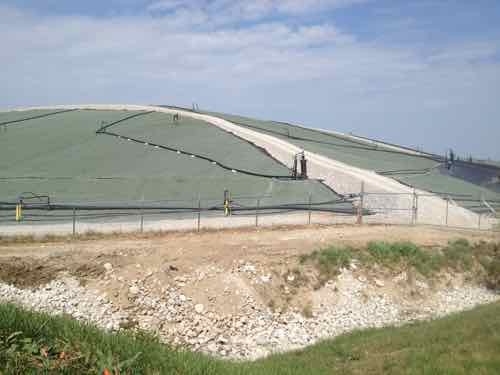Readers: Underground Landfill Fire More Likely Than Not Will Reach Radioactive Waste Within a Year
None of us know for sure when, if ever, the underground chemical reaction (aka fire) at the Bridgeton Landfill will reach the radioactive waste in the adjacent West Lake Landfill. Hopefully it never will.

But until something is done — such as an underground concrete barrier — people in the vicinity have reasons to be concerned. For those unfamiliar, here’s some basics.
The Bridgeton Landfill, was originally a farm, then a quarry — which closed in 2005.
On Dec. 23, 2010, Bridgeton Landfill LLC reported to the MDNR that elevated temperatures had been detected in some gas extraction wells in the south quarry of the landfill. The facility began testing the landfill gas and found high levels of hydrogen and carbon monoxide and low levels of methane. All these conditions are indicative of a below-ground, high-temperature chemical reaction, also known as a “subsurface smoldering event” or “underground fire.”
Technically, this is not a “fire” with smoke and flames. Rather, it is a self-sustaining, high-temperature reaction that consumes waste underground, producing rapid “settlement” of the landfill’s surface. (KWMU: Confused about Bridgeton, West Lake landfills? Here’s what you should know — RECOMMENDED)
And radioactive waste at West Lake?
1973: Radioactive waste from the Manhattan project is dumped at the site. St. Louis was one place where uranium and radium were refined for the atomic bombs that were eventually dropped on Japan. A private company eventually bought the waste from the US government in the 1960s to extract minerals.
The waste was eventually crushed like rocks or dirt. The company later mixed the material with five parts of top soil to dilute it. 48,000 tons of contaminated soil was trucked to the landfill and presented as clean fill dirt for spreading on trash. All of this was done at a time when environmental regulation were lax compared with today. (KMOV: Bridgeton Landfill: How the current situation came to pass — RECOMMENDED)
In St. Louis, Mallinckrodt Chemical Works was one of many Manhattan Project sites in the U.S. and Canada.
There isn’t even agreement on the distance between the underground fire and the radioactive material. The corporation that owns the Bridgeton Landfill says 2,500 feet, the EPA & Missouri Attorney General Chris Koster say it is 1,000 feet away. Last month St. Louis County released has a draft plan for an emergency response to a catastrophic event,
Further reading:
- St. Louis County West Lake Landfill page
- Missouri Department of Natural Resources: Bridgeton Landfill
Here are the Sunday Poll results:
Q: Likelihood of Bridgeton Landfill’s underground fire (chemical reaction) reaching radioactive waste in the adjacent Westlake Landfill in a year?
- Unsure/No Answer 9 [29.03%]
- Very likely 8 [25.81%]
- Somewhat likely 6 [19.35%]
- Very unlikely 4 [12.9%]
- Somewhat unlikely 3 [9.68%]
- Neural 1 3.23% [3.23%]
The likely/unlikely ratio is 45.16%/25.58% — with 32.26% in the middle. I received an email about an upcoming town hall meeting tomoerrow:
Open to the public town hall meetings with:
State Representative Bill Otto
Mark Dietrich – St. Louis County Director of Emergency Planning
Dawn Chapman – concerned citizen, admin of Facebook: West Lake Landfill (18000 members) and co-founder of JustMomsSTL
Robbin Dailey – resident of Spanish Village
Thursday, Nov 12th 7-9 PM
Graphic Artists Banquet and Conference Center
105 Progress Parkway
Maryland Heights, MO 63043
Sponsored by Parkway Pattonville Democratic Township Club
— Steve Patterson
The real question is “And then, what?” How much radiation will be released? What will the real impact be? Versus the fear of “any” being released? We live with background radiation every day, our cell phones emit radiation. Sure, no fire and no release would be great, but what will be the actual change in measurements? 0.0001% increase?!
There are many questions, including yours.
Do we remove the radioactive waste that was illegally dumped? Where do we take it & how?
Do we build a concrete barrier between the two landfills?
Do we try to stop the underground fire?
Do we need a better disaster plan?
The radioactive waste should be dug up and relocated. There isn’t very much of it (not by Hanford, Savannah River Site, or even Los Alamos standards) It’s way too close to an urban area; and the waste is uncharacterized, so we don’t actually know how toxic it is. The safest thing to do is to move it all to Hanford or WIPP or Idaho, which are the three main repositories of Manhattan Project waste. If it turns out it isn’t too toxic it could go to Andrews in Texas or Clive in Utah.
http://www.news.com.au/technology/environment/residents-in-st-louis-dying-in-record-numbers-from-world-war-ii-radioactive-waste/news-story/3626e996b759f6e4694abe61b7416975
http://qz.com/490331/recently-found-in-american-backyards-nuclear-waste-from-the-manhattan-project/
Once the radioactive waste and heavy metals are removed, let the underground fire burn. It’s pretty damn near impossible to put those things out.